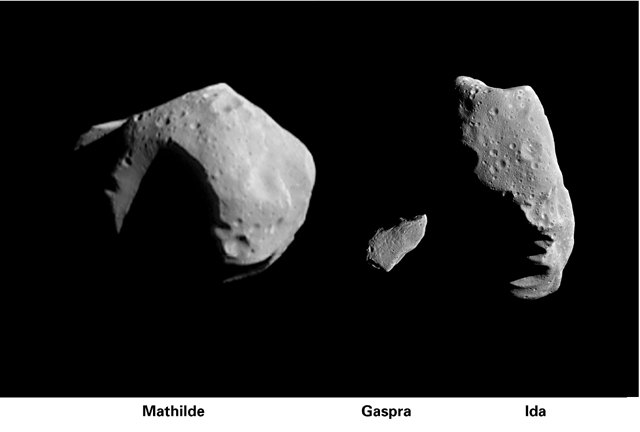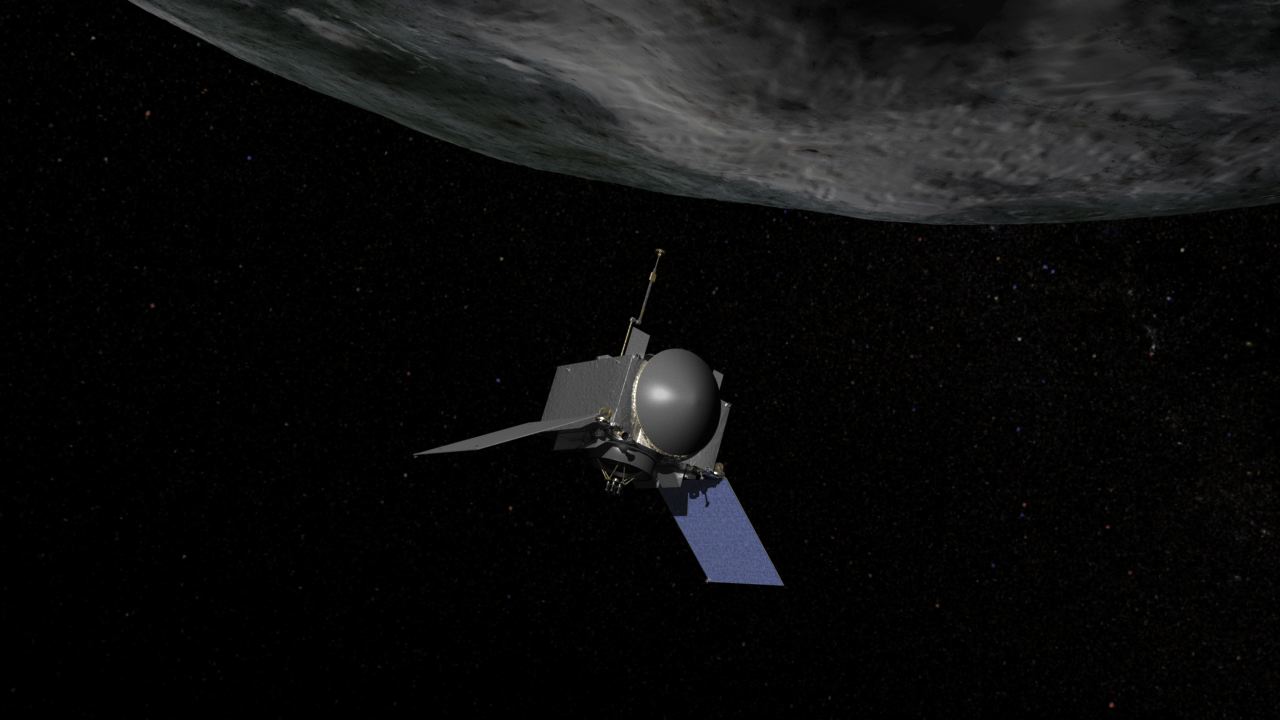Over the last hundred years, the human population has exploded from about 1.5 billion to more than seven billion, driving an ever-increasing demand for resources. To satisfy civilization’s appetite, communities have expanded recycling efforts while mine operators must explore forbidding frontiers to seek out new deposits, opening mines miles underground or even at the bottom of the ocean.
Asteroids could one day be a vast new source of scarce material if the financial and technological obstacles can be overcome. Asteroids are lumps of metals, rock and dust, sometimes laced with ices and tar, which are the cosmic “leftovers” from the solar system’s formation about 4.5 billion years ago. There are hundreds of thousands of them, ranging in size from a few yards to hundreds of miles across. Small asteroids are much more numerous than large ones, but even a little, house-sized asteroid should contain metals possibly worth millions of dollars.
There are different kinds of asteroids, and they are grouped into three classes from their spectral type – a classification based on an analysis of the light reflected off of their surfaces. Dark, carbon-rich, “C-type” asteroids have high abundances of water bound up as hydrated clay minerals. Although these asteroids currently have little economic value since water is so abundant on Earth, they will be extremely important if we decide we want to expand the human presence throughout the solar system.
“Water is a critical life-support item for a spacefaring civilization, and it takes a lot of energy to launch it into space,” says Dante Lauretta of the University of Arizona, Tucson, principal investigator for NASA’s OSIRIS-REx asteroid sample return mission. “With launch costs currently thousands of dollars per pound, you want to use water already available in space to reduce mission costs. The other thing you can do with water is break it apart into its constituent hydrogen and oxygen, and that becomes rocket fuel, so you could have fuel depots out there where you’re mining these asteroids. The other thing C-type asteroids have is organic material – they have a lot of organic carbon, phosphorous and other key elements for fertilizer to grow your food,” said Lauretta.

Somewhat brighter asteroids have a stony composition. These “S-type” asteroids have very little water but are currently more economically relevant since they contain a significant fraction of metal, mostly iron, nickel and cobalt.
“However, there are a fair amount of trace elements that are economically valuable like gold, platinum and rhodium,” said Lauretta. “A small, 10-meter (yard) S-type asteroid contains about 1,433,000 pounds (650,000 kg) of metal, with about 110 pounds (50 kg) in the form of rare metals like platinum and gold,” said Lauretta.
There are rare asteroids with about ten times more metal in them, the metallic or “M-class” asteroids, according to Lauretta.
However, it currently costs hundreds of millions to billions of dollars to build and launch a space mission, so innovations that would make these costs fall dramatically are needed before it is profitable to mine asteroids for the value of their metals alone.
Another obstacle is simply our lack of experience with mapping and analyzing the resources in asteroids to extract material from them. This critical experience will be gained with NASA’s asteroid sample return mission, OSIRIS-REx (Origins, Spectral Interpretation, Resource Identification, Security and Regolith Explorer).
Credits: NASA/Goddard Space Flight Center
The spacecraft, scheduled for launch in September 2016, will arrive at the asteroid Bennu in October 2018 and study it in detail before returning with a sample of material from its surface. Its primary purpose is scientific — since asteroids are relics from our solar system’s formation, analysis of the sample is expected to give insights into how the planets formed and life originated. Also, the spacecraft will accurately measure how the tiny push from sunlight alters the orbit of Bennu, helping astronomers better predict this influence on the path of any asteroid that presents an impact risk to Earth.
“However, the mission will develop important technologies for asteroid exploration that will benefit anyone interested in exploring or mining asteroids, whether it’s NASA or a private company,” said Lauretta.
The mission is designed to have triple redundancy for its sample acquisition – if the first attempt fails, the team can try two more times to get at least 60 grams (about two ounces) of sample, and up to 2,000 grams (about 4.4 pounds). To make the most of these opportunities, the spacecraft is equipped with instruments that map the asteroid’s composition from orbit, allowing the team to select the best sample sites well in advance of the first attempt.
A good way to determine an asteroid’s composition from a distance is to analyze its light. All materials reflect, emit, and absorb light at specific colors or frequencies depending on the properties of the material. The make-up of a material can be identified using special instruments called spectrometers which measure the intensity of light at different frequencies.
Materials emit and absorb light over an extremely wide range of frequencies, well beyond what our eyes can see, so OSIRIS-REx has three spectrometers that together cover this range in the X-ray, visible and infrared.
The OSIRIS-REx Visible and Infrared Spectrometer (OVIRS) detects visible and near-infrared light. Infrared light is invisible to the human eye, but we can feel it as heat. This spectrometer will be able to detect organic compounds in addition to a variety of minerals and other chemicals. Organic compounds contain carbon and are of interest because some are used by life. The team hopes to sample a site rich in organic molecules for clues to the organic chemistry in the early solar system that led to the emergence of life on Earth. “OVIRS will help map the distribution of organic molecules on the asteroid and guide sample site selection based on that information,” said Lauretta.
The OSIRIS-REx Thermal Emission Spectrometer (OTES) goes deeper into the infrared range and will detect minerals on the surface of Bennu and measure the temperature of the asteroid. In particular, clay minerals found by OTES will provide a map of the water-rich material on the asteroid. Just as beach sand heats up quickly in the sun and cools off rapidly at night while the pavement stays hot long after sunset, the rate at which the surface warms in the day and cools at night will be used to measure the surface properties.
The Regolith X-ray Imaging Spectrometer will look at the faint X-ray glow of the sunlit surface to map the distribution and abundance of elements, such as iron, silicon, sulfur, and magnesium.
OVIRS and OTES also will work together to determine the influence of sunlight on Bennu’s orbit. This influence, called the Yarkovsky effect, happens when the surface of an asteroid absorbs sunlight and later radiates it as heat while the asteroid rotates, giving the asteroid a tiny push, which adds up over time to significantly change its trajectory.
OVIRS will reveal how much sunlight is reflected from Bennu. Since what’s not reflected must be absorbed, the team can use this measurement to calculate how much sunlight is being stored by the asteroid to be later radiated as heat. OTES will measure this heat and provide a map to show which areas on Bennu radiate the most, giving the direction of the Yarkovsky push.
The light detected by the spectrometers doesn’t penetrate far, so these instruments can identify composition only in a thin layer near the surface, not more than about one-half of a millimeter deep (about a hundredth of an inch). It’s likely that Bennu’s composition changes deeper in its interior. The mission’s sampling mechanism will go deeper by blowing nitrogen gas to agitate material near the surface, forcing it to flow into a collection chamber.
“We’ll get down five or six centimeters (around two inches) with this technique,” says Lauretta. Although still relatively shallow, it is about 200 times deeper than with spectrometry alone.
“Also, the spectroscopists will tell us that they know the composition of this material, but at the end of the day, we get to test that,” adds Lauretta. “We’ll bring a sample back to the lab and say, alright you guys said it was made out of this, we found it was made out of that, did you get it right or not?”
Other instruments will help refine the composition maps from the spectrometers. The smallest features in the OVIRS chemistry maps will be about 20 meters (yards) across, while the OTES mineralogy features are even bigger, at about 40 meters across. Color maps from the cameras will have much higher resolution, less than a meter, so any variations in color over a feature in the chemistry and mineralogy maps from the spectrometers gives a clue that perhaps the composition changes a bit in those areas, according to Lauretta.
Similar to radar, the laser altimeter instrument will bounce laser light off the surface of Bennu to build a three-dimensional map of its shape and surface features. Measuring how brightly the surface reflects the laser light can give a clue to the type of material present; for example, a really bright reflection could indicate they hit a metallic spot, according to Lauretta.
Although developed for science, the instruments on OSIRIS-REx are similar to those necessary for an asteroid mining mission.
“The mission will be a proof-of-concept – can you go to an asteroid, get material, and bring it back to Earth,” said Lauretta. “Next, people will have to industrialize it so that the economy works out, so for the recoverable value in any given asteroid, you’re spending half that to bring it back.”
“The only thing you might want to add is the ability to do a quick chemical analysis of material on board the spacecraft, so you can say, ‘The platinum concentration is X,’ for example,” says Lauretta. “We couldn’t afford it – that’s a pretty sporty option. Other than that, for anyone who’s thinking about an asteroid mission, this is the set of instruments that you want to fly.”
The University of Arizona, Tucson, is the principal investigator institution which leads the mission. NASA’s Goddard Space Flight Center, Greenbelt, Md., provides overall mission management, systems engineering, and safety and mission assurance. Lockheed Martin Space Systems is building the spacecraft. OSIRIS-REx is the third mission in NASA’s New Frontiers Program.
William Steigerwald
NASA’s Goddard Space Flight Center, Greenbelt, Md.





























